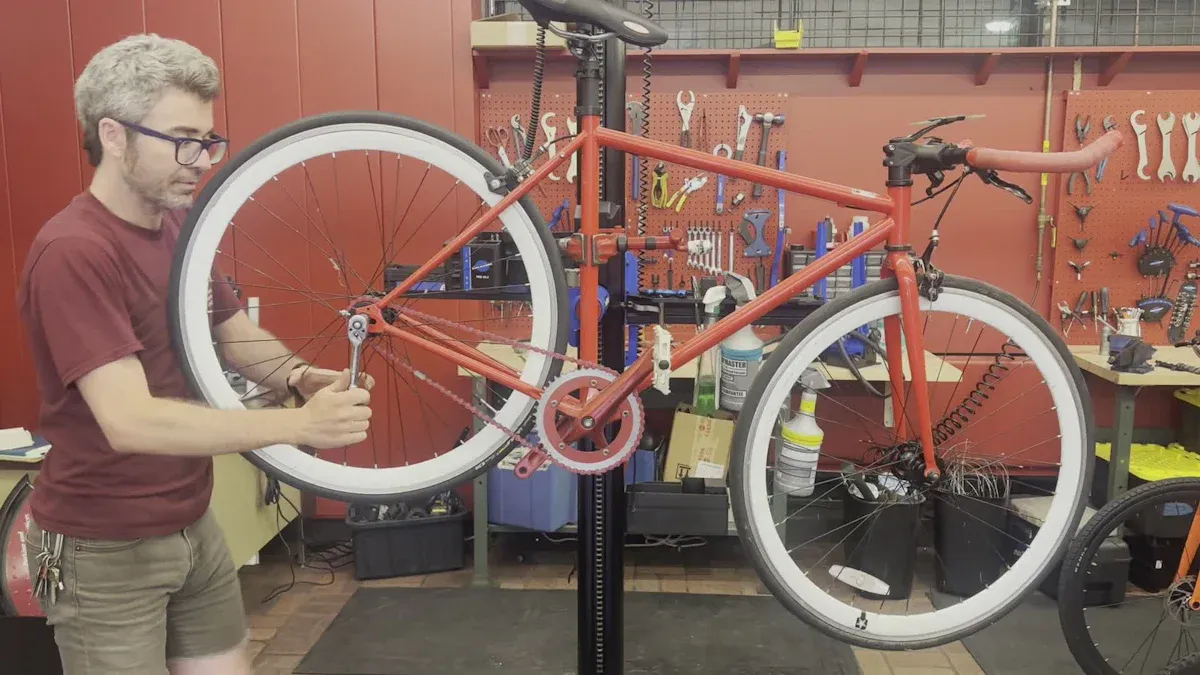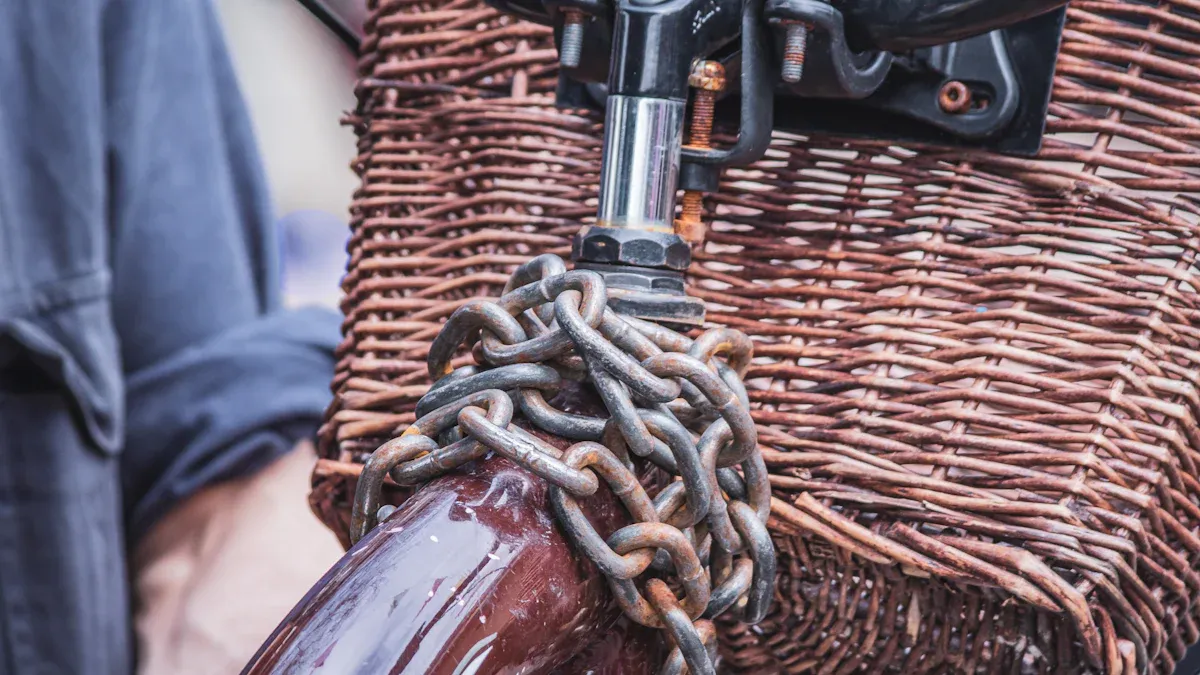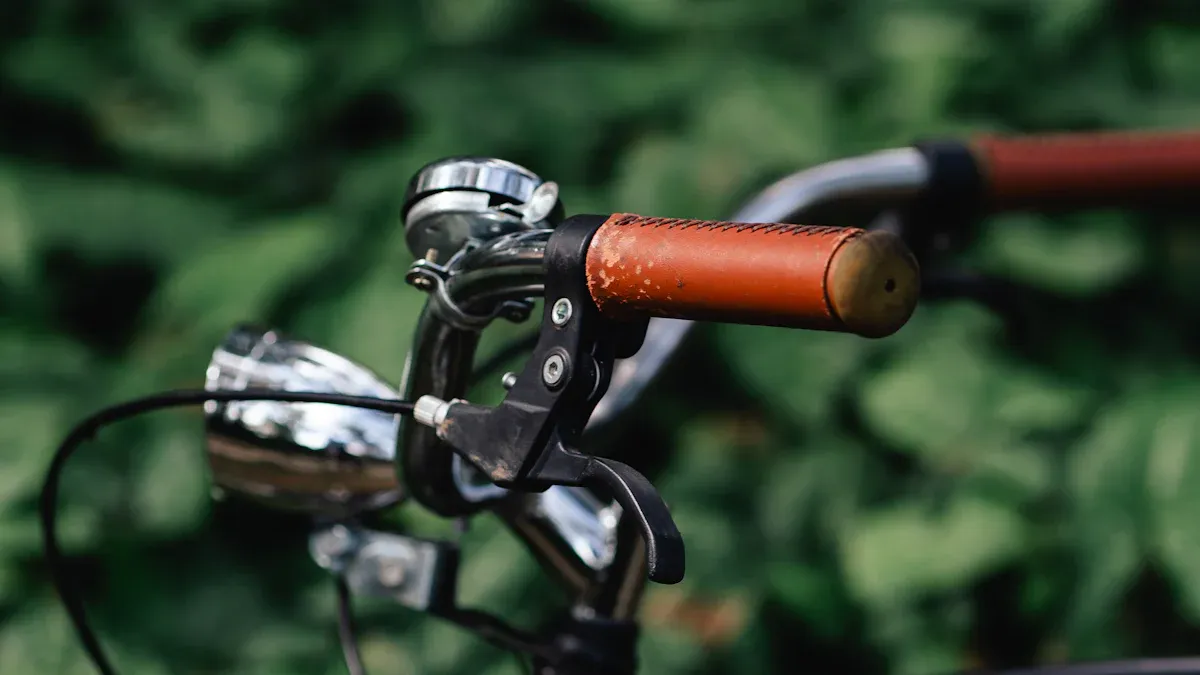
Restoring an old steel bike feels like a trip back in time. You’re not just fixing a bike; you’re bringing back a piece of history. Many fans are getting into classic and vintage bicycles, and it’s easy to see why! Restoration gives new life to these bikes, and it’s also a smart choice for the planet. Did you know that fixing a vintage bike is much better for the environment than making new frames? This makes steel bike frame restoration a green hobby. So, if you’re ready to work hard and bring that old steel bike back to life, let’s get started!
Key Takeaways
Fixing a vintage steel bike frame is good for the environment. It helps save history and cuts down on waste.
Use good rust removal methods like phosphoric acid or vinegar. These will clean your bike frame safely and well.
Regular care is important. Check for rust and damage every few months. This keeps your bike in great shape.
Think about using original parts when you restore your bike. This can increase its value and keep it real.
Look for community resources like Re:Ciclos and Working Bikes. They can help you with support and tools for your restoration.
Vintage Steel Frame Basics

When you think about vintage steel frames, some key features come to mind. These frames usually use 1020 type or hi-ten steel. This gives them a special ride quality. Unlike modern frames made from high-tensile steel or chromoly, vintage steel frames have a springy feel. They absorb bumps in the road very well. This makes your rides more comfy, especially on long trips.
Here’s a quick comparison of vintage and modern steel frames:
Characteristic | Vintage Steel Frames | Modern Steel Frames |
|---|---|---|
Material | Usually 1020 type or hi-ten steel | High-tensile steel and chromoly steel |
Ride Quality | Springy feel, absorbs road bumps | Better comfort with vibration damping |
Geometry | Relaxed shapes, softer rides | Made for performance and comfort |
Different quality, often less consistent | High-quality craftsmanship improves feel | |
Weight | Usually heavier due to thicker walls | Thinner walls without losing strength |
The strength of the frame is very important. A strong frame keeps you safe and helps your bike last longer. For example, some users have shared stories where their vintage frames were straightened and kept most of their original strength. But, there’s always a chance of future problems. One user rode a bent down tube for 10,000 miles before it cracked. This shows that even if a frame feels safe, it can still weaken over time.
When restoring your vintage steel bike frame, always look for any signs of damage. A well-kept frame not only makes your ride better but also keeps the bike’s authenticity. Remember, the goal is to keep that classic feel while making sure it is safe and easy to ride.
Steel Bike Frame Restoration: Rust Removal

Rust can be a big problem when fixing your vintage steel bike frame. But don’t worry! You have many good ways to deal with this. Let’s look at both chemical and mechanical ways to remove rust, plus some important cleaning tips.
Chemical and Mechanical Methods
For rust removal, you can pick chemical or mechanical methods. Each has good and bad points, so let’s explain them:
Chemical Methods:
Phosphoric Acid: This strong acid removes rust faster than the metal. It also prepares the surface for paint.
Naval Jelly: This is an easy-to-use option with phosphoric acid. It removes rust without hurting the metal below.
White Vinegar: If you want a safe and cheap choice, vinegar works great. Soak rags in vinegar and wrap them around the rusted spots overnight for good rust removal.
Mechanical Methods:
Sanding: This way is usually safer but might not work well for deep rust. Use sandpaper or a sanding block to get rid of surface rust.
Dremel Tools: These are perfect for tight spaces. They help you remove rust in hard-to-reach spots.
Tip: Always wear safety gear when using chemical methods. Protect your eyes and skin, and work in a place with good air flow.
Surface Cleaning Techniques
Before you start removing rust, it’s important to clean your bike frame. Here are some good techniques:
Technique | Description |
|---|---|
Use this method to take paint off a steel frame. Sandblasting is a common term for this process. | |
Glass Bead Blasting | A gentler way than sandblasting that is less harsh on steel tubing. |
Protecting Surfaces | Use duct tape and old parts to cover areas from damage during blasting. |
Cleaning Before Blasting | Get rid of oil, grease, and rust to stop them from getting stuck in the metal during blasting. |
Rust Removal | Try to remove rust down to bare metal, leaving only gray. Pits are okay if they aren’t deep. |
Phosphoric Acid Treatment | After sanding, use phosphoric acid to eat away rust without hurting the steel. |
Derusting Before Blasting | It’s best to remove rust before blasting to make sure deep rust pits are fixed. |
Preventative Measures
After you’ve removed rust, you’ll want to stop it from coming back. Here are some good ways to prevent rust:
Use a rust inhibitor like Frame Saver™ or Boeshield T-9™ inside your frame at least once a season.
After wet rides, take out your seat post and turn your bike upside down overnight to let water drain out.
Check your frame often for paint chips and fix them to protect the exposed steel.
At the end of each riding season, take off all parts from your frame to reapply rust inhibitor and grease the parts.
By following these steps, you can keep your vintage steel bike frame in great shape for years. Remember, a little work in rust removal and prevention helps keep your bike’s authenticity and rideability.
Frame Repair Techniques
When you fix a vintage steel bike frame, you may find different kinds of damage. Spotting these problems early can help you save time and money. Here are some common types of damage you might see:
Rust Damage: This is usually the biggest problem. You may notice surface rust that needs special treatment.
Paint Damage: Rust treatment can sometimes harm the paint, so be ready for that.
Cracks and Dents: These can happen from years of use or accidents.
Identifying Damage
Start by looking closely at your frame. Check for any signs of rust, cracks, or dents. Use a flashlight to find hidden problems. Pay extra attention to joints and areas that get a lot of stress, like the bottom bracket and seat stays.
Tip: Regular checks during maintenance are very important. Listen for strange sounds while riding; they might mean there are hidden issues.
Welding and Soldering
After you find damage, you may need to fix it. Welding and soldering are two good ways to repair steel frames. Here’s a summary of the safest and strongest welding methods:
Method | Description | Advantages |
|---|---|---|
Best for its precision and strength. | Great for thin tubing, gives good flexibility and strength. | |
MIG Welding | Faster and easier to learn, but not great for thin stock. | Good for thicker materials, quick for making things. |
Gas Welding | A budget-friendly choice for occasional repairs. | Useful for many projects, good for brazing. |
TIG Welding: This method is best for precision and looks. It’s great for custom builds where you want a clean finish.
MIG Welding: This is quicker and easier to learn, making it popular with many hobbyists. However, it’s not as good for thin materials like bike frames.
Gas Welding: This method is cost-effective and works well for occasional fixes. It’s flexible and can also be used for brazing.
When you weld, think about the material’s flexibility and strength. Flexibility lets the frame bend before breaking, while strength helps it absorb energy without cracking. For the best results, use a filler metal like ER70s-2, which cleans and removes oxidation well.
If you find that a frame tube is too damaged to fix, you may need to replace it. Here’s how that process is different from fixing small cracks or dents:
Process | Description |
|---|---|
Takes a lot of work, keeping the right size and alignment, often needs brazing or welding new parts. | |
Can be done with easier methods like filling, welding over, or using bondo, without needing to change the tube. |
Replacing a frame tube is sometimes needed to fix a valuable frame. It needs careful work to make sure everything lines up correctly. On the other hand, fixing small cracks can often be done with simpler methods, making it easier than replacing a tube.
Note: Bad frame repairs can cause serious safety problems. Regular checks are very important to catch issues early.
By knowing these repair techniques, you can successfully restore your vintage steel bike frame while keeping its authenticity and ensuring safety.
Finishing Touches for Restoration
After all your hard work on your vintage steel bike frame, it’s time for the final touches. This part is very important. It makes the bike look better and keeps it safe for a long time. Let’s go over the steps for painting and coating, plus some key maintenance tips.
Painting and Coating
When you paint your bike, you have many choices. Here are some popular options:
Powder Coating: This method is very strong. It makes a tough finish that resists scratches and chips better than regular paint.
Cerakote: This ceramic coating is even tougher. It works well on metal and can handle rough conditions.
Clear Coats: These protect the paint from UV damage. But, they might wear out over time, so check them often.
To get long-lasting results, use materials that fight corrosion. Here’s a quick look at some good options:
Material/Treatment | Description | Effectiveness |
|---|---|---|
Reynolds 853 | Very effective against rust. | |
Gun blue followed by oil | A treatment for steel frames that helps resist rust. | Moderate effectiveness. |
Polished surface | Keeping a polished surface slows down rust. | Effective if kept up. |
Clear coatings over raw steel | Extra layer to protect raw steel from rust. | Effective if done right. |
Regular Maintenance Tips
To keep your restored bike in great shape, do regular maintenance. Here’s a simple checklist:
Put the bike on a stand for easy access.
Use a dry cloth or compressed air to remove dirt and debris.
Check the frame for rust, dents, or peeling paint.
Clean the frame with warm water and pH-neutral soap.
Gently scrub with a soft brush to remove dirt.
Dry with a microfiber cloth to avoid water spots.
Apply wax or sealant to protect the paint.
Regularly check for rust and reapply wax or polish as needed.
Upgrading parts can also improve your bike’s performance without losing its vintage look. Think about getting ‘rider’ wheels while keeping the original ‘show’ wheels. You might also want to upgrade brakes and drivetrain parts for better safety and efficiency.
By following these painting, coating, and maintenance tips, you’ll keep your vintage steel bike frame looking great and riding smoothly for years.
Fixing up your vintage steel bike frame can be a fun adventure. You will face challenges like checking the frame’s quality and finding parts that fit. Remember, using good materials and original parts can really increase your bike’s value. Here are some important things to think about:
Frame Materials: Look for strong steel like Reynolds or Columbus.
Components: Original parts can raise the value.
Condition: Bikes that are well-kept are more popular.
Don’t forget to check out resources like Re:Ciclos and Working Bikes for help. They provide tools and community support for your restoration work. With patience and care, you can make your vintage bike look great again while keeping its true character! 🚴♂️
FAQ
What tools do I need for rust removal?
You will need sandpaper, a wire brush, or a Dremel tool for mechanical methods. For chemical methods, get some phosphoric acid or vinegar. Always wear safety gear to keep yourself safe!
How can I tell if my frame is too damaged to repair?
Look for deep cracks, bad rust, or bent tubes. If you see a lot of damage, think about asking a professional. They can help you decide if repairs are possible.
Can I use modern parts on my vintage bike?
Yes, you can! Many modern parts fit vintage frames. Just make sure they match your bike’s specifications. Upgrading parts can improve performance while keeping the vintage look.
How often should I maintain my restored bike?
Try to check it every few months. Look for rust, clean the frame, and put on protective coatings again. This keeps your bike looking good and riding well.
Is it worth restoring a vintage bike?
Definitely! Restoring a vintage bike keeps history alive and can be good for the environment. Plus, you will enjoy a special ride that is different from modern bikes.
See Also
Essential Tips for Caring for Your Steel Bicycle Frame
Proven Methods to Eliminate Rust from Your Bike Frame
Best Practices for Safely Painting Carbon Bike Frames
